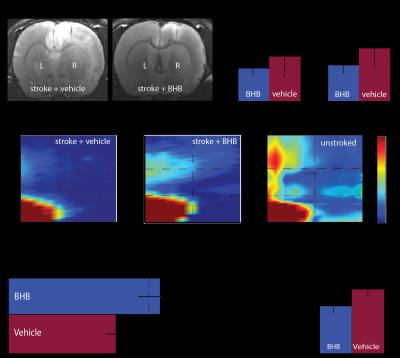2447
Modulation of the peri-infarct neurovascular function by Beta-HydroxybutyratePaolo Bazzigaluppi1, Evelyn Lake2, Margaret Koletar3, Rafal Janik4, James Mester5, Conner Adams6, Peter Carlen7, and Bojana Stefanovic4
1Medical biophysics, Sunnybrook Research institute, Toronto, ON, Canada, 2Yale University, CT, United States, 3Sunnybrook Research Institute, 4Sunnybrook Research Institute, ON, Canada, 5Sunnybrook Research Center, ON, Canada, 6ON, Canada, 7Krembil Research Intitute, Toronto, ON, Canada
Synopsis
In view of the failure of neurocentric treatments for ischemic stroke, this work examines a pleiotropic modulation of the neurogliovascular unit exerts beneficial effects in the treatment of brain stroke. Oxydative metabolism of glucose in the peri-ischemic tissue has potentially detrimental effects on tissue; in contrast, ketones’ metabolism - in light of the reduced amount of oxygen required - provides a safer alternative. We employed functional CASL, in situ electrophysiology, and biochemical analysis to show short-term benefits of early administration of β-Hydroxybutyrate to metabolically challenged brain tissue following focal ischemia.
Introduction
Due to the oxygen dependence of the glycolytic pathway [1], production of ATP in ischemic tissue is accompanied by generation of Reactive Oxygen Species (ROS) that induce tissue damage. The aim of this work was to test the efficacy of providing a ketone body, an alternative metabolic substrate, in the acute post-ischemic phase so as to reduce ROS production and improve neurogliovascular recovery.Methods
To examine the susceptibility of the neurogliovascular unit to metabolic modulation in the acute stage of focal ischemic stroke, we delivered a ketone body (β-Hydroxybutyrate, BHB; 100mg/kg i.p.) one hour after ischemic insult induced by direct cortical microinjection of endothelin-1 (ET-1) in sensorimotor cortex of adult rats (800 pico moles, as in our previous work [2]). We examined cerebrovascular reactivity to hypercapnia imaged on continuous arterial spin labeling (CASL) MRI, resting state field potentials recorded with intra-cortical multi-electrode array, and ROS production on post mortem biochemical analysis in BHB- vs. vehicle-treated cohort 48 hours after stroke induction.Results
In line with our previous study [2], transient hypercapnia in the vehicle treated cohort elicited exaggerated cerebrovascular reactivity in the peri-lesional tissue (1.8 土 0.5 times larger blood flow increase in lesioned vs. un-lesioned hemisphere). In contrast, BHB treated cohort showed reduced lateralization of the CBF response to hypercapnia (1.3 土 0.8 times larger blood flow increase in lesioned vs. un-lesioned hemisphere). T2-weighted RARE showed a trend towards toward reduction of hyper-intense tissue volume in the BHB treated cohort (Figure 1A). Resting state local field potentials recorded in situ following MR imaging showed a decrease in theta-band power in the peri-lesional tissue (0.75 土 0.22 mV/mV*Hz-1 lesioned/un-lesioned hemisphere), which was rescued (1.1 土 0.02 mV/mV*Hz-1 lesioned/un-lesioned hemisphere) in the BHB-treated cohort (Figure 1C). We also estimated Modulation Index (as in [3], Figure 1B), a measure of phase-amplitude coupling between theta and gamma bands. Vehicle-treated animals showed lower theta to gamma modulation than did the BHB treated rats. BHB treatment also resulted in reduced ROS production in lesioned vs. un-lesioned hemisphere (lesioned/un-lesioned hemispheric ratio of 1.52 土 0.2 in vehicle-treated vs. 1.31 土 0.3 in BHB-treated, Figure 1D).Conclusions
Our data suggest that administration of a ketone body in the acute stage of focal ischemic stroke may have multiple beneficial effects for the neurogliovascular unit recovery. Studies are currently underway to assess the effects of this treatment on the lon-term sensorimotor functional recovery.Acknowledgements
No acknowledgement found.References
[1] H.D. Demopoulus, E.S. Flamm, D.D. Pietronigro, M. Seligman, (1980) The free radical pathology and the microcirculation in the central nervous system disorders [2] Evelyn M.R. Lake, Paolo Bazzigaluppi, James Mester, Lynsie A.M. Thomason, Rafal Janik, Mary Brown, JoAnne McLaurin, Peter L. Carlen, Dale Corbett, Greg J. Stanisz, Bojana Stefanovic, (2016) Neurovascular unit remodelling in the subacute stage of stroke recovery. Neuroimage. In press [3] Canolty et al (2006) High Gamma Power is phase locked to Theta Oscillations in human neocortex. ScienceFigures

A)Structural-MRI of vehicle- vs. BHB-treated rats injected with
ET-1. The peri-lesional tissue exhibits inflammation-induced hyperintensity in T2-weighted signal. Histograms show a trend toward reduced stroke volume in the
BHB treated cohort.;B)Multi-Electrode-Array electrophysiological recordings from
the peri-lesional region show increased Modulation Index (MI) in the BHB-treated animals (non-stroked subject
data displayed for reference).
Heat plots are population averages (n=8 BHB, n=6 Placebo);C)Power
analysis shows reduced lateralization between the peri-and
the contralesional cortex (n=8 BHB, n=6 vehicle) two days post-stroke;D)Reactive Oxygen Species (ROS) production is reduced in the peri-lesional
cortex of the BHB-treated (n=4) vs. vehicle-administered rats (n=5) (p=0.034) two days post-stroke.